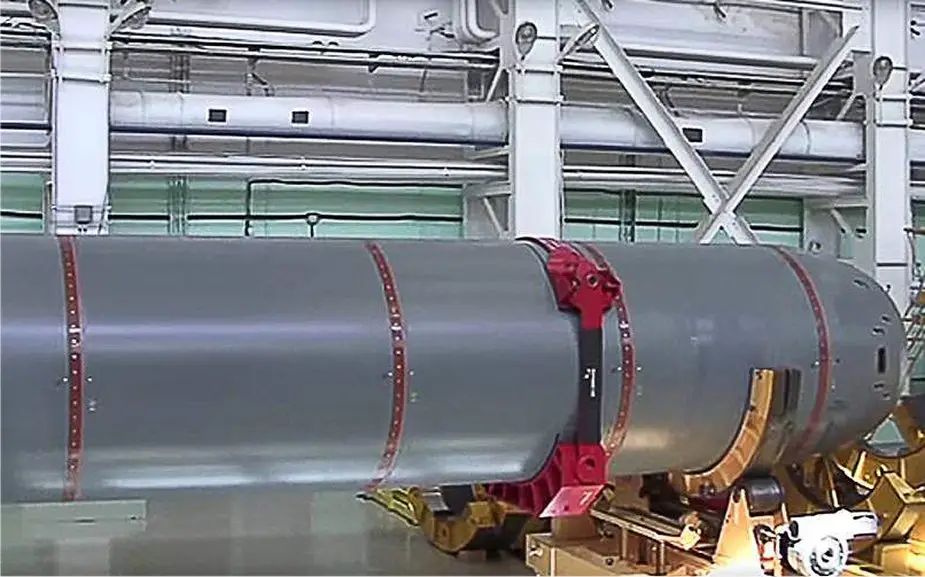Breaking news
Analysis: Russia completes production of first nuclear Poseidon torpedo.
According to information published by Tass on January 25, 2023, Russia has produced the first set of nuclear Poseidon super torpedoes for the Belgorod nuclear submarine. The main units of Poseidon, including the nuclear power plant have been successfully tested.
Follow Navy Recognition on Google News at this link
 Russian Poseidon torpedo. (Picture source: IZ)
Russian Poseidon torpedo. (Picture source: IZ)
Poseidon
The project of a strategic torpedo with a nuclear warhead emerged in the USSR in late 1940s — early 1950s. Researchers and the military studied the possibility to deploy nuclear warheads of a big mass and size on various carriers.
As a result, the idea of 24-meter long T-15 super torpedo of 1530 mm caliber emerged. The steam-gas torpedo with a nuclear warhead had to have a range of 30-60 km and strike at coastal targets by nuclear explosion and subsequent tsunami.
In mid-1950s, the design of T-15 was stopped because of a negative assessment of the Navy, which criticized it for a slow speed, short range, high noise and poor protection of the torpedo and the carrier.
In 1960s, physic Andrey Sakharov promoted the idea of delivering powerful thermonuclear charges to hostile coast. He designed AN-602 Tsar Bomb of 26.5 tons. However, nether available aircraft nor missiles could carry it.
In September 2015, western online media quoted Pentagon sources as saying Russia had designed an unmanned underwater craft with a nuclear warhead of dozens of megatons. The codename was allegedly Canyon.
On November 1, 2015, Russian TV reported the presentation of “multirole oceanic system Status-6” for the destruction of important hostile economic facilities on the coast. The carriers were the Belgorod and the Khabarovsk submarines under construction at the time. No official comment followed.
On March 1, 2018, President Vladimir Putin announced the creation of an unmanned underwater nuclear-powered craft. A popular vote on the Defense Ministry website called it Poseidon. On July 19, the ministry said trials had begun.
Poseidon is likely a development of Status-6. In April 2019, a defense industry source told TASS the Belgorod submarine would be floated in Severodvinsk on April 23. Another source said the submarine can carry six strategic torpedoes.
It was reported in January 2019, that the strategic unmanned vehicle will develop a maximum underwater speed of 200 km/h. “It will sail at a depth of one kilometer and a speed of 200 km/h and more (110 knots),” the source said. Poseidon sails at maximum speed in an air cavern (water steam) that reduces water resistance.
On the way to the target, Poseidon constantly maneuvers by the course and depth, which makes it impossible to intercept it, the source said.
In early January 2023, the source said the Belgorod submarine had completed pop-up trials of a Poseidon mockup. They successfully tested the launch system.
Belgorod
The characteristics of the Belgorod nuclear submarine are kept secret. She was developed from an uncompleted submarine of Antey-class project 949A.
Sevmash Shipyard laid the submarine on July 24, 1992, but the construction was suspended in 1997. Attempts were made in 2000s to resume the construction by upgraded project 949AM, but the effort failed because of a lack of financing. In early 2010s, it was decided to build the Belgorod by new project 09852 designed by the Rubin Bureau in St. Petersburg. The submarine with factory number 91664 was re-laid on December 20, 2012 in the presence of Navy Commander-in-Chief Viktor Chirkov.
The United Shipbuilding Corporation and Sevmash initially called the Belgorod a research submarine for remote ocean areas. She had to participate in rescue operations, release and inspect underwater research equipment, and monitor underwater transport routes.
It was reported that the submarine would carry unmanned underwater rescue craft. On April 21, 2017, the Izvestia daily quoted the Navy command as saying that Rubin Bureau had re-designed the central part of the submarine.
The missile compartment was replaced by a longer one with docking chambers for divers and underwater craft. The length of the submarine increased from 154 to 184 meters (11 meters longer than the biggest Soviet submarine of Akula-class project 941). The Belgorod thus became the longest submarine in the Russian Navy.
In November 2018, the Defense Ministry reported the formation of the submarine crew. In April 2019, the Belgorod was floated. She was initially scheduled to join the Navy in 2020, however trials dragged and COVID-19 pandemic was a reason.
In June 2021, a shipbuilding source told TASS the Belgorod had begun running trials. Acceptance trials followed in the summer of 2022 in the Barents Sea.
The Belgorod joined the Russian Navy on July 8, 2022. The Khabarovsk submarine of project 09851 under construction since 2014 is likely to be the second carrier of Poseidon.




























